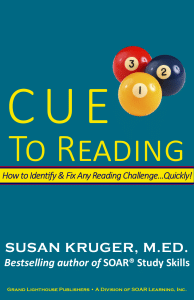Cue To Reading Bonus Material
We hope that you have been enjoying the book, Cue to Reading!
To access your free bonus materials, please fill in the information below.
If you have not read Cue to Reading yet, you can purchase it here.

Cue to Reading, by Susan Kruger, M.Ed.
Cue to Reading will:
- Give you the power to identify reading problems/disabilities.
- Teach you a deep understanding of the different reading problems/disabilities.
- Arm you with the proper tools and strategies to fix each individual problem/disability.
- Help guide you on your journey of what to do, and where to go next.
I suffered through school with undiagnosed learning disabilities. But nothing was more difficult than the 3-year emotional roller-coaster with my son, Mark, and his reading disabilities in school. I wrote Cue to Reading with the intention of changing student’s lives and the lives of their parent’s too! I’m a certified reading specialist with a “best-selling” education book, SOAR Study Skills. But, when I suspected my son had dyslexia, I found it impossible to get help!
If you have found yourself in the same situation, look no further. Join me, along with the hundreds of other parents, students, and teachers on the Cue to Reading path to success! No matter the stage in diagnoses, or if they haven’t even been diagnosed yet, the problem/disability can be fixed.
In Cue to Reading, I share the best practices on science-based strategies to conquering reading disabilities. I share them in the context of specific examples with my son and other students to best illustrate them and make them more personal.
Cue to Reading is made up of 15 no fluff, straight-to-the-point chapters. Those 15 chapters are then broken into 3 simple, easily digested sections. Visual aids, essential strategies, research, teaching, and life experience are what make up the backbone to this book. Just below are the 15 steps on the path to reading success!
The 15 essential steps to success in, Cue to Reading:
1. When a Parent Knows Something is Wrong
2. The Three Cueing Systems of Reading
3. Cueing into a Problem-The Most Important Cueing System in Reading
4. When Mistakes are Golden
5. Brain Biology of Learning Disabilities
6. A Simple Learning Solution Hiding in Plain Sight
7. Why Reading Level Is Overrated
8. “He’s Just Not Tryin’”
9. “I Hate Teaching Reading”: Journey of a Reading Teacher
10. What to do & Where to go
11. The “Power” Reading Strategy
12. Strategies for the Context/Meaning Cueing System
13. Strategies for the Syntax/Grammar Cueing System
14. Strategies for the Visual/Decoding Cueing System
15. Creating Effective Lessons for a LD/ADHD Student
Q: Can I adapt the reading disability strategies found in Cue to Reading to a high school setting?
You sure can! We hope that students with reading disabilities can be identified and helped as early as possible, but most reading disabilities are not identified until later, if at all. That means that you will have plenty of chances to use the diagnostic and instructional strategies from Cue to Reading with older students.
The cueing systems we use to read don’t change as we get older. Miscue analyses are useful with any age students; just use age-appropriate texts.
In terms of instruction, you can accomplish a lot just by teaching your young adult students about the three cueing systems. Because they usually have more cognitive power than younger readers, they should have an easier time drawing connections between the systems and their own reading.
Two other resources which are aimed at younger students but are useful for older struggling readers are All About Spelling and Uncovering the Logic of English. When using either program with older readers, just put a book cover on your teacher’s manual and call it “Linguistics.” That will put the program in terms that are more appropriate for older students.
To learn more about Cue to Reading, you can purchase it here.
SK 012715
